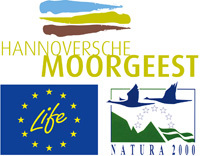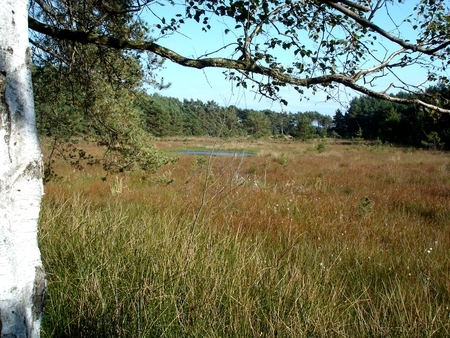
Schwarzes Moor near Resse
Located at the centre, on underlying birch carr, is a sapric peat layer up to 1.2 metres in thickness, which is covered by fibric peat. The fringes consist of low-bogs peat and sapric peat layers ranging from 0.30 to 0.90 metres in thickness. The soil is otherwise influenced by groundwater and impounded water.
Schwarzes Moor is drained by a system of ditches. In the east the water is conducted to the “Resser Graben” ditch, and in the south it is conducted directly into the “Auter” brook.
The manual peat cutting sites used until the mid-20th century have led to the formation of dense undergrowth, thus creating the impression of a wooded landscape. Nevertheless, at its centre, the body of the raised bog is characterised by open marshland areas including erica (Erica tetralix) and Scots heather (Calluna vulgaris), tall cotton grass (Eriophorum angustifolium), tussock cotton grass (Eriophorum vaginatum), and peat moss (Sphagnum). Continuous quaking peat moss mats have developed at the sites formerly used by farmers for manual peat extraction. Pine- and birch-dominated bog woodland with a well-developed herb layer and birch carr vegetation has developed on the edge of the bog. The woodland contains a high proportion of lying and standing deadwood. The areas, used agriculturally in some cases as grassland, are bordered by extensive buckthorn scrub (Frangulo-Salicetum auritae) and tall herbaceous vegetation.
The southern fringe of Schwarzes Moor is a habitat for breeding birds such as the lapwing (Vanellus vanellus), yellow wagtail (Motacilla flava), skylark (Alauda arvensis), red-backed shrike (Lanius collurio) or nightingale (Luscinia megarhynchos). Schwarzes Moor is too small for easily disturbed species such as the crane (Grus grus) or Eurasian curlew (Numenius arquata) to breed there, although reptiles, amphibians and water-bound insects such as dragonflies are to be found there in large numbers.
It has been possible for species with a propensity for dry and warm environments, such as certain butterflies and grasshoppers, to settle in the drained fringe areas of the bog not intensively utilised for agricultural purposes. Species not typically found in these surroundings, such as the large marsh grasshopper (Stethophyma grossum) and the short-winged conehead (Conocephalus dorsalis), can also be found there, however.

Artikel-Informationen
Ansprechpartner/in:
Susanne Brosch
Nds. Landesbetrieb für Wasserwirtschaft, Küsten- und Naturschutz
Betriebsstelle Hannover-Hildesheim
- Projektleitung Life+ Moorgeest
Göttinger Chaussee 76 A
D-30453 Hannover
Tel: +49 (0)511 / 3034-3115



